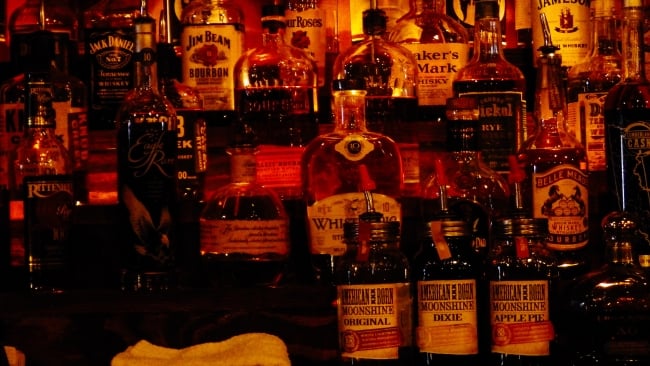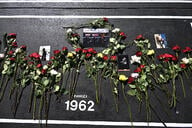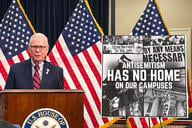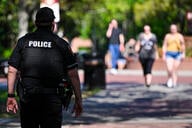You have /5 articles left.
Sign up for a free account or log in.

Spablab | Flickr
The next few months could be a more lucrative time for bars in Hanover, N.H.
The home of Dartmouth College is not especially known for its bar scene, with many students choosing instead to drink on campus at fraternity parties. When the spring term began on March 30, however, so did a new ban on hard liquor on campus, and the town's bars are now among the few places a student can drink a margarita without running afoul of the new policy.
"I'm sure we will see an increase of students," Marc Milowsky, the owner of Molly’s Restaurant and Bar, said Friday. "There is a vibe around town. People are wondering, 'What will this mean?'"
The new alcohol policy, announced in January, prohibits the possession or consumption of alcohol that is 30 proof or higher by anyone on campus, including those who are over 21. Penalties will be increased for students found in possession of hard alcohol, and third-party security and bartenders will be required at campus social events.
It’s the college’s boldest move yet in an ongoing attempt to change its rowdy, drunken reputation. But will it work?
According to a 2001 survey conducted as part of Harvard University’s College Alcohol Study, students at colleges with complete drinking bans are 30 percent less likely to be “heavy episodic drinkers” and more likely to abstain from alcohol. Among students who still drink, however, heavy drinking is just as common as among their counterparts at colleges without alcohol bans.
The report has other caveats: the survey found a correlation between banning alcohol and lower rates of heavy drinking, the authors wrote, but that the lower rates could be due "to other factors, such as self-selection of students to these schools.” The report also focused on colleges that have banned all alcohol, not just hard liquor.
Colleges that have banned hard liquor are often convinced that it's the main source for their alcohol-related woes: hospitalizations, poor academic performance, sexual assault and other kinds of violence. They hope that banning hard liquor will help curb some of students' most harmful drinking habits, such as drinking from the open bowls of spiked punch found at fraternity parties, or the practice of "pregaming," in which students may drink large quantities of alcohol in an attempt to get drunk before even leaving their homes for the evening.
At Bowdoin College, where about 20 students are sent to the hospital every year due to overdrinking, the dean of student affairs said he can only recall two or three students ever being hospitalized after drinking too much beer or wine. He's been dean there for nearly 20 years.
George Koob, the director of the National Institute on Alcohol Abuse and Alcoholism at the National Institutes of Health, said he agrees that administrators should focus their efforts on these types of behaviors. According to the institute, binge drinking has decreased among college students in recent years. But, at the same time, alcohol-related hospitalization has increased as much as 70 percent. “We have seen a fairly dramatic increase of alcohol-related hospitalizations among college students,” Koob said. “There’s an attitude now to drink as fast as possible and as intensely as possible. That's very dangerous.”
The idea has its opponents. Sexual assault prevention advocates say alcohol bans can make victims who have been drinking more hesitant to come forward. Critics also warn that hard liquor bans just push the drinking off campus, meaning Dartmouth would actually have less control over student safety.
In an interview the day the college announced the ban, Philip Hanlon, Dartmouth's president, admitted that the ban carries such a risk, although with Dartmouth being located in the tiny town of Hanover, he said, there's not much "off campus" to speak of. "It's something to be mindful of and to look out for," he said. "But it is not a reason not to adopt the ban."
The next state over, in Maine, hard liquor bans are commonplace at small, private liberal arts colleges.
In 2008, 14 students at Colby College were hospitalized for alcohol poisoning in a single day during an annual senior celebration known as Champagne Steps. The celebration was soon canceled, and two years later the college adopted a hard liquor ban.
“Since the policy went into effect, both hospitalizations and blood alcohol levels have dropped notably,” the college states on a webpage devoted to “facts and myths” about drinking at Colby. “The purpose of the policy is to eliminate high alcohol content punches and so-called pregaming that involves students doing multiple shots of hard alcohol in a short period of time prior to attending other events.”
The number of emergency room visits related to alcohol in recent years appears to be about same as it was in the years directly prior to the ban. In the 2013-14 academic year, there were 50 alcohol-related hospitalizations at Colby. From 2004 to 2009, an average of 46 students a year were treated for alcohol poisoning, according to a report created by a working group at the college. A Colby spokeswoman said this week, however, that there has been a "20 percent reduction in dangerous drinking" since the ban was adopted; the higher number of emergency room visits, she said, is attributable to the campus health center ceasing to be open 24 hours a day.
Nearby Bates College has had a similar ban in place since 2001. Though it varies year by year, it’s not uncommon to see a similar number of hospital transports as at Colby, but it tends to be lower. In 2010, nearly a decade into the ban, 34 Bates students were sent to the emergency room after drinking too much (the number has fallen into the 20s in some years since the ban).
That’s double the number of students hospitalized at Bowdoin College, another Maine institution with a hard liquor ban. The college also prohibits drinking games like beer pong and flip cup. Last year, there were only 15 alcohol-related hospital transports at Bowdoin. Over the last decade, about 20 students per year have been transported to the hospital in relation to alcohol use.
Bowdoin’s alcohol ban has been in effect since 1999, but Scott Hood, the college’s vice president for communications and public affairs, cautioned against attributing Bowdoin’s low number of alcohol hospitalizations solely to the ban.
"It is combined with educational programming, open dialogue, enforcement, students looking out for one another and other measures, and we believe the practice has served Bowdoin and our students very well,” Hood said. “Nevertheless, I’m not sure our situation is transferable elsewhere. Different campuses have different cultures.”
Every year, first-year students receive a letter from Bowdoin’s dean of student affairs, Tim Foster, warning them of the risks -- both to their health and to their academic and career aspirations -- of heavy drinking.
“Please know that if you choose to drink excessive amounts of alcohol while at Bowdoin, it will be one of the riskiest and most dangerous things you will do,” Foster writes, adding that half of those hospitalized in a given year are first-year students who consumed too much hard alcohol. “Poor decisions by individuals and the irresponsible use of hard alcohol, especially in the form of ‘pregaming’ and ‘ripping shots,’ were the common denominators. In my 18 years at the college, only a handful of students have been taken to the hospital because they had too much beer or wine to drink.”
If Dartmouth hopes to drive its number of student hospitalizations down to Bowdoin-like levels, it doesn’t have much farther to go. Even with a student body twice as large, Dartmouth has already cut its number of annual hospital transports related to overdrinking down from 80 in 2011 to 31 last year. And that’s without any hard liquor ban in place.
But Hanlon said he views this milestone as a plateau, and hard alcohol is the “key challenge that remains” in lowering the number even more. “We’re viewing hard alcohol as a challenge facing our campus right now and were going to take it on,” he said in January.
Two months after the announcement and one full weekend into the ban, it’s not yet clear if Dartmouth’s policy will prevent that kind of dangerous behavior. It will take time to fully assess its effectiveness, said Justin Anderson, a spokesman for Dartmouth, and the university “can’t speculate” on how the policy has or hasn’t changed things this early into its adoption.
Across the street at Molly’s, Milowsky said he’s reserving judgment for now, as well. The number of students in the bar was especially high on Friday and Saturday, he said, but it was also a holiday weekend and so it could have been a holiday crowd. He said it will take at least a month to “determine if there is any pattern” related to Dartmouth’s new policy.
“I’m sure the students are going to test the waters,” Milowsky said on Monday. “I don’t think anything substantial will happen until a couple of incidents occur, and I guess then we’ll see what’s what.”




